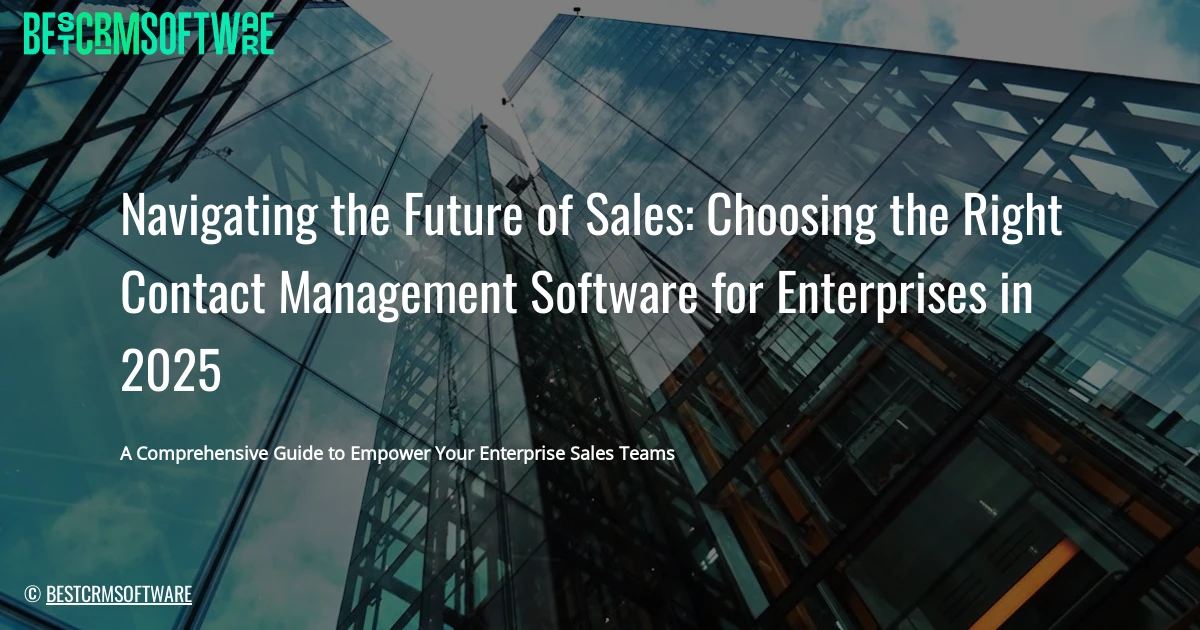A Comprehensive Guide to Empower Your Enterprise Sales Teams
Introduction: Embracing Intelligent Contact Management in 2025
The B2B sales landscape is undergoing a dramatic transformation, driven by the rise of digital channels, the increasing complexity of buyer journeys, and the relentless demand for data-driven insights. To thrive in this evolving environment, enterprises need to embrace automation and Artificial Intelligence (AI) to enhance their sales strategies. This means streamlining operations, optimizing processes, and unlocking the power of their customer data.
One crucial area demanding this transformation is contact management. Large enterprises, with their expansive customer databases, often struggle to manage this valuable resource effectively. Outdated contact management systems, built for a bygone era, often lack the agility, scalability, and intelligent capabilities needed to navigate the data-driven world of 2025.
The limitations of these traditional systems become particularly apparent when faced with the following challenges:
- Managing vast datasets: Enterprises need solutions capable of handling millions of contacts without compromising speed and performance.
- Ensuring data accuracy and consistency: Maintaining clean, reliable contact data is essential for successful outreach and personalized experiences.
- Leveraging data for intelligent insights: Modern systems should extract meaningful data points and insights to optimize campaigns and enhance customer interactions.
The time is ripe for enterprises to rethink their approach to contact management. Moving beyond outdated systems and embracing intelligent solutions is the key to staying ahead in the dynamic world of B2B sales.
Defining Your Enterprise Requirements
Navigating the future of sales demands a robust contact management software that aligns perfectly with your enterprise’s unique needs. This journey begins with a deep understanding of your existing workflows, challenges, and future aspirations.
Here’s how to define your enterprise requirements:
1. Key Functionalities to Consider:
- Contact Organization: How effectively can the software manage a massive contact base? Do you require robust segmentation capabilities, custom fields, and personalized contact views?
- Communication Tracking: Does it seamlessly integrate with your communication channels like email, phone, and social media? Can it track all interactions, schedule follow-ups, and generate automated reminders?
- Pipeline Management: Does it provide comprehensive visibility into your sales pipeline? Does it offer robust deal management tools, forecasting capabilities, and personalized dashboards?
- Reporting & Analytics: Does it provide insightful reporting and analytics that help you understand performance, identify bottlenecks, and optimize strategies?
2. Identifying Specific Needs and Pain Points:
Beyond the key functionalities, delve into your sales organization’s specific needs and pain points.
- Are your reps struggling to stay organized and manage a large number of leads?
- Are communication channels fragmented and inefficient?
- Do you lack insights into deal progress and performance metrics?
Address these pain points by looking for features that specifically address these issues.
3. Determining Must-Have Features vs. Nice-to-Have Features:
It’s crucial to prioritize features based on their impact on your sales process.
- Must-Have Features: Essential functions that directly impact efficiency, productivity, and sales performance. Examples include robust contact organization, integrated communication tracking, and basic pipeline management.
- Nice-to-Have Features: Features that enhance the user experience, offer greater flexibility, or streamline specific tasks. Examples include advanced automation, custom reporting templates, and integrations with specific CRM tools.
By understanding your specific needs, challenges, and desired functionalities, you can develop a comprehensive checklist of features that will guide you toward choosing the right contact management software for your enterprise in 2025 and beyond.

© ELEVATE
Exploring Different Types of Sales Contact Management Software
As businesses navigate the rapidly evolving landscape of 2025, selecting the right contact management software is crucial for achieving sales success. But with numerous options available, the decision can be overwhelming. To guide your choice, we need to understand the different categories and their inherent advantages and disadvantages:
1. Cloud-based vs. On-Premise Solutions: Understanding the Pros and Cons
- Cloud-based solutions: These are hosted on external servers, accessible via internet browsers.
- Pros:
- Scalability: Easily expand your capacity as your team grows without investing in additional hardware.
- Accessibility: Access data and manage contacts from any device with internet access.
- Cost-effectiveness: Lower initial investment and ongoing maintenance costs.
- Automatic updates: Constant access to the latest features and security enhancements.
- Cons:
- Internet dependence: Requires a stable internet connection for seamless functionality.
- Security concerns: Potential vulnerability to data breaches if security measures are not robust.
- Limited customization: May not be as customizable as on-premise solutions.
- Pros:
- On-premise solutions: These are installed and maintained on your own company servers.
- Pros:
- Complete control: Total ownership of data and full customization of the system.
- Higher security: Reduced risk of data breaches when implemented correctly.
- Offline access: Accessible even without an internet connection.
- Cons:
- High initial cost: Requires significant upfront investment for software, hardware, and maintenance.
- Limited scalability: Expanding capacity can be expensive and time-consuming.
- Software updates: Managing updates and maintenance falls entirely on your IT team.
- Pros:
2. Exploring Industry-Specific Solutions Tailored for Your Vertical
Instead of generic contact management platforms, many enterprises are embracing industry-specific solutions. These software cater to the unique requirements of your vertical, offering:
- Pre-built templates: For contracts, proposals, or communications, tailored to your industry.
- Specific integrations: With crucial tools and platforms specific to your business sector.
- Dedicated features: Addressing common challenges and streamlining workflows specific to your industry.
For example, a fintech firm might benefit from a solution specifically designed for financial services, equipped with features like client risk assessments, compliance tracking, and investment analysis tools.
3. Examining the Benefits of Integrated Platforms vs. Standalone Tools
The decision of using integrated platforms versus standalone tools depends on your individual needs and business processes.
- Integrated platforms: These encompass multiple functions beyond contact management, offering tools for CRM, marketing automation, sales pipelines, email marketing, and more.
- Pros:
- Centralized data: A unified platform ensures a single source of truth for all your customer interactions.
- Streamlined workflows: Integrate various processes seamlessly within one platform for efficient operations.
- Improved collaboration: Facilitates communication and collaboration between sales, marketing, and customer service teams.
- Cons:
- Steeper learning curve: Might require significant time and training to master its diverse features.
- Higher costs: Can be more expensive than standalone tools due to their expanded functionalities.
- Pros:
- Standalone tools: Focus specifically on contact management, providing specialized features like lead capturing, segmentation, and interaction tracking.
- Pros:
- Specific functionalities: Deliver tailored tools that perfectly match your specific contact management requirements.
- Ease of use: Simplifies adoption and training, focusing on core functionalities.
- Lower costs: Often offer more affordable pricing compared to integrated platforms.
- Pros:
By carefully analyzing your specific business needs, the unique demands of your industry, and the advantages and limitations of different types of solutions, enterprises can confidently choose the contact management software that empowers them to navigate the future of sales in 2025 and beyond.
Top Contenders: Reviewing Leading Contact Management Platforms
As enterprises gear up for the sales landscape of 2025, selecting the right contact management software is crucial for success. Here’s a look at three industry giants vying for top spot:
Salesforce: This titan of the CRM world has long been the benchmark for its vast feature set and unmatched scalability. Salesforce caters to a wide range of businesses, offering tools for every stage of the sales cycle, from lead generation to account management and customer service. Their robust automation capabilities, integration with various platforms, and unparalleled customization options make Salesforce a top choice for organizations with complex needs and vast data.
Microsoft Dynamics 365: A powerful contender, Microsoft Dynamics 365 boasts seamless integration with the entire Microsoft ecosystem, a boon for companies heavily invested in Office 365 and other Microsoft products. Known for its user-friendly interface and focus on process automation, Dynamics 365 excels at streamlining sales workflows and enhancing team collaboration. Its focus on analytics provides valuable insights into customer behavior, allowing businesses to make data-driven decisions.
SAP Sales Cloud: Designed for enterprise-scale operations, SAP Sales Cloud offers a powerful solution tailored for large, complex organizations. This software features a holistic approach to managing customer relationships, covering every aspect from lead qualification and opportunity management to forecasting and sales planning. SAP Sales Cloud shines in its advanced analytics capabilities and industry-specific features, making it a popular choice for companies dealing with complex sales cycles and diverse customer profiles.
While these three giants stand out, the ideal platform will ultimately depend on an enterprise’s unique needs and priorities. Evaluating each software’s strengths and weaknesses, factoring in integration capabilities, scalability, and user-friendliness is paramount for making the right choice and successfully navigating the future of sales.

© Elevate Digital
Exploring Other Popular Choices
While Salesforce continues to dominate the market, a plethora of other powerful solutions cater to specific needs and budgets. Here are some compelling alternatives that deserve serious consideration:
- Zoho CRM: Zoho CRM presents itself as a highly cost-effective solution that punches above its weight in terms of feature richness. Offering a comprehensive suite of tools spanning marketing automation, sales pipelines, customer service, and project management, Zoho shines in its versatility and affordability, making it a strong contender for businesses seeking a full-fledged CRM solution without breaking the bank.
- Pipedrive: Known for its clean and intuitive user interface, Pipedrive excels at streamlining the sales process. Its pipeline-focused design makes it a favorite amongst sales teams seeking to visually manage and track opportunities effectively. Its intuitive design and strong focus on sales process optimization makes Pipedrive a go-to for businesses emphasizing clear pipeline visibility and smooth deal flow.
- Freshsales: Freshsales balances powerful automation with a deep focus on personalized engagement, making it a standout choice for companies prioritizing building lasting customer relationships. Freshsales empowers sales teams with tools like automated workflows, AI-powered lead scoring, and robust email marketing, all aimed at streamlining processes and facilitating personalized customer interactions.
Prioritizing Data Security and Compliance
In an age of increasingly sophisticated cyber threats, data security and compliance are not just considerations, they are cornerstones in choosing the right contact management software. Your enterprise’s sensitive customer information – names, contact details, purchase history, and even financial data – is at stake. Choosing a platform that prioritizes data security and compliance should be a non-negotiable part of your selection process.
Here’s how to ensure data security and compliance remain paramount:
- Ensuring the chosen software aligns with your company’s privacy policies: This might seem obvious, but many platforms offer a broad range of features, some of which may contradict your company’s strict privacy standards. Scrutinize the platform’s terms of service, privacy policy, and data retention policies. Confirm their alignment with your own data usage guidelines and compliance regulations (e.g., GDPR, CCPA).
- Verifying data encryption standards and data center locations: Look for platforms using robust encryption protocols like AES-256 to secure data both at rest and in transit. Additionally, investigate their data center locations and ensure they meet your compliance standards. Check if they comply with relevant regulations (e.g., HIPAA, ISO 27001) and offer certifications like SOC 2 Type II.
- The critical role of data security and compliance in choosing a platform: Data security and compliance should be a cornerstone of your decision. Your customer’s data is precious, and you must select a platform that is equipped to handle it with the utmost security.
Ultimately, choosing the right contact management software requires a deep understanding of your enterprise’s specific needs. Investing in a platform that prioritizes data security and compliance will not only safeguard sensitive customer information but also build trust and foster long-term relationships.

© Pixabay
Evaluating Cost Considerations and ROI
Choosing the right contact management software is a significant investment, and it’s crucial to carefully evaluate cost considerations and potential return on investment (ROI).
Here’s how to break down these factors:
Understanding Different Pricing Models:
- Subscription-based: This is the most common model, offering a recurring monthly or annual fee for access to features. It often provides predictable costs and allows for scalability.
- Tiered: Tiered pricing presents different feature packages at varying costs. Select a tier that balances functionality with your budget and current needs.
- Usage-based: Costs vary depending on usage, such as the number of users, contacts, or features used. This model can be attractive for companies with fluctuating usage needs, but it requires careful budgeting and monitoring.
Considering Implementation, Training, and Ongoing Support Costs:
- Implementation: Initial setup and configuration require time and effort, potentially requiring dedicated resources or consultants. Assess these costs early on.
- Training: Familiarizing users with the software through training sessions and resources is critical for adoption and effective utilization.
- Ongoing Support: Factor in the cost of technical support, updates, and ongoing maintenance to ensure seamless operation and system optimization.
Calculating Potential Return on Investment (ROI):
- Increased Sales Efficiency: Streamline lead management, sales cycles, and communication efforts leading to improved sales performance and increased revenue.
- Improved Customer Relationships: Enhance customer engagement and build stronger connections through personalized communication and a robust database of customer information.
- Reduced Administrative Costs: Automate tasks like lead scoring, follow-ups, and data entry, reducing manual labor and administrative costs.
- Enhanced Data Insights: Utilize reporting and analytics tools to extract valuable data, enabling informed decision-making and improved sales strategies.
Calculate ROI by:
- Estimating the cost savings and revenue increase from the software.
- Subtracting the total cost of implementation, training, and support.
- Dividing the result by the total cost.
In Conclusion:
Thorough evaluation of cost considerations and ROI is crucial when selecting a contact management software solution. Understand different pricing models, factor in implementation, training, and support costs, and carefully calculate the potential return on investment. By aligning the software’s capabilities with your needs and budgetary constraints, you can make a strategic and profitable decision for your enterprise.
Seamless Integration: A Critical Success Factor
The journey to a successful contact management system in 2025 hinges heavily on its seamless integration with your existing ecosystem. A smooth transition and effortless data flow are crucial for maximizing ROI and minimizing disruption. This section highlights three critical areas to consider:
1. The importance of seamless data migration from existing systems:
Data is the lifeblood of your sales operations. Switching to a new contact management system should not mean losing precious insights or creating data silos. Prioritize software that offers efficient and accurate data migration capabilities from your existing CRM, marketing automation tools, and other relevant platforms. This ensures you start off with a complete and reliable picture of your contacts and interactions.
2. Assessing the integration capabilities with your current tech stack:
Your chosen system needs to play nicely with the tools your team already uses. Look for software with strong integration capabilities for tools like marketing automation, email marketing, social media platforms, and customer support software. A well-integrated system streamlines processes, reduces redundancies, and improves communication across teams.
3. Evaluating API access and open integration options:
For ultimate flexibility and customization, choose a contact management platform that offers comprehensive API access and open integration options. This allows you to tailor the system to your unique needs, connect it with emerging technologies, and leverage the power of custom workflows. It also provides a platform for future growth and ensures compatibility with new solutions that may arise in the future.
Ultimately, choosing a contact management software with robust integration features empowers your organization to operate efficiently, access comprehensive insights, and navigate the ever-changing landscape of sales technology in 2025 and beyond.

© fauxels
Scalability and Future-Proofing Your Choice
Choosing a contact management software is an investment in your sales success, and it’s crucial to select a solution that can adapt and grow with your business. Here are three key factors to consider when evaluating scalability and future-proofing:
1. Understanding the software’s ability to scale as your business grows.
- User Capacity: How many users can the platform accommodate? As your sales team expands, the platform should effortlessly handle increased logins and user activity without impacting performance.
- Data Storage and Processing: Can the software manage an ever-expanding database of contacts and interactions without slowing down? Look for a solution with a flexible data infrastructure that can handle significant increases in volume.
- Workflow Flexibility: The ability to adapt workflows to evolving sales processes is critical for growth. Ensure the platform offers customizable workflows and integrations that can scale along with your sales strategy.
2. Evaluating the platform’s capacity for handling large contact databases.
- Contact Organization and Segmentation: Your contact management solution should allow you to effectively organize and segment your database, facilitating targeted communication and personalized engagement. Look for features that allow for advanced filtering, tagging, and custom fields for comprehensive contact categorization.
- Data Integrity and Management: Maintaining data accuracy is vital. Ensure the platform provides tools for duplicate contact detection, data cleansing, and ongoing data management.
- Data Insights and Reporting: Your solution should be able to provide actionable insights from your data. Analyze trends, measure campaign performance, and track key metrics with robust reporting features.
3. Ensuring the solution supports global operations and multiple teams.
- Internationalization and Localization: For businesses operating in multiple regions, your CRM must support different languages, time zones, and cultural nuances. Ensure it seamlessly adapts to diverse user needs and global operations.
- Collaboration and Team Management: As teams grow and operate across geographic locations, your CRM must facilitate seamless collaboration and communication. Look for features such as shared inboxes, team dashboards, and permission settings to ensure effective coordination.
- Integration with Other Business Systems: Your CRM should integrate smoothly with other crucial systems like email marketing platforms, marketing automation tools, and sales intelligence software.
By considering these factors, businesses can select a contact management software that not only meets their present needs but also allows them to scale their sales efforts and operations effectively for future success.
Focusing on User Adoption and Training
As enterprises embrace cutting-edge contact management software in 2025, it’s critical that the technology is not just advanced, but also readily adopted by the sales team. To ensure seamless integration and maximize ROI, solutions must prioritize user adoption and training through the following key elements:
- Leveraging user-friendly interfaces and intuitive dashboards: The days of complex, clunky interfaces are over. In 2025, successful software will boast clean, user-friendly interfaces and intuitive dashboards. This intuitive design encourages user engagement, fosters a seamless workflow, and eliminates the steep learning curve often associated with new systems.
- Providing adequate training resources for efficient onboarding and adoption: Effective training is the cornerstone of user adoption. Software vendors must equip their customers with comprehensive onboarding materials, including detailed user guides, interactive tutorials, and on-demand videos. This comprehensive approach empowers users to understand the software’s features and capabilities, enabling them to confidently utilize it in their daily sales operations.
- Ensuring easy access to customer support and online help documentation: In addition to initial training, continuous support is essential for user success. Software providers should prioritize quick and responsive customer support channels, whether it be through email, phone, or live chat. They should also offer accessible online help documentation, allowing users to self-serve and find answers to their queries at any time.
By emphasizing user adoption and training, software providers can ensure their solutions are not just powerful, but also effectively utilized. This strategic approach fosters long-term engagement, ultimately empowering sales teams to leverage the technology and drive tangible results in 2025.

© Anamul Rezwan
The Power of Integrations: Enriching Contact Data
As enterprises navigate the evolving sales landscape of 2025, it’s clear that contact management software needs to evolve beyond simply storing contact information. The key lies in integrating with other essential platforms to create a rich, actionable picture of every customer.
Here are three critical ways contact management software can be enhanced through strategic integrations:
1. Moving beyond traditional contact data: Utilizing social media insights.
Social media is a treasure trove of information about potential and existing customers. By integrating contact management software with social media platforms, businesses can:
- Gather insights on customer interests, preferences, and brand perception. This allows for more personalized sales outreach and tailored messaging.
- Track online conversations, sentiment analysis, and trending topics relevant to specific contacts. This equips sales teams with a real-time understanding of customer behavior.
- Identify key influencers and decision-makers within a company. Targeted outreach based on social media influence can yield more effective results.
2. Enhancing contact profiles with data from marketing automation platforms.
Marketing automation platforms provide invaluable insights into customer journeys and interactions. Integrating them with contact management software creates a powerful synergy:
- Enriching contact profiles with behavioral data: Capture website visits, email engagement, download activity, and other marketing-driven touchpoints.
- Tailoring sales follow-up based on specific customer actions. This ensures a personalized and targeted approach, significantly boosting conversion rates.
- Predicting potential sales opportunities based on marketing data: This enables proactive outreach and relationship building with high-value customers.
3. Creating a 360-degree view of customer interactions and preferences.
By integrating with CRM systems, communication platforms, and other relevant tools, contact management software can provide a holistic picture of the customer:
- Track interactions across multiple channels: From phone calls, emails, and website activity to social media conversations, all touchpoints are captured in a central database.
- Gain a unified understanding of customer preferences: This enables more accurate forecasting, segmentation, and personalization.
- Boost cross-department collaboration: Sales, marketing, and customer service can all leverage the same enriched customer data, fostering a more unified approach.
By leveraging these strategic integrations, contact management software will evolve from a simple data storage solution into a powerful platform for driving sales success in 2025.
Harnessing Automation and AI for Sales Optimization
The future of sales hinges on maximizing efficiency and effectiveness, and contact management software is a key tool in this transformation. As we move towards 2025, enterprises must embrace the power of automation and AI to streamline their sales processes.
Automating routine tasks to free up sales reps for value-adding activities: Imagine a world where tedious tasks like data entry, follow-up emails, and scheduling appointments are handled automatically. Contact management software equipped with AI-powered automation capabilities can achieve this, liberating sales reps from repetitive work and allowing them to focus on building relationships, closing deals, and strategizing for future growth.
Utilizing AI-powered features for lead scoring, nurturing, and segmentation: AI can revolutionize how businesses interact with leads. By analyzing vast datasets and identifying key patterns, contact management software can provide insights into lead quality, enabling accurate scoring. This information empowers sales teams to prioritize their outreach, ensuring they connect with the most qualified prospects first. Furthermore, AI-driven lead nurturing programs can automate personalized communications, tailoring interactions to individual needs and interests, resulting in higher engagement and conversion rates. Segmentation tools fueled by AI allow for the creation of targeted campaigns based on specific demographics, behaviors, and purchase history, delivering tailored messaging for maximum impact.
Improving workflow efficiency and sales rep productivity through automation: Streamlined workflows are crucial for optimizing sales productivity. Contact management software can automate repetitive tasks across various stages of the sales funnel, from lead qualification to deal closure. Automated follow-ups, meeting reminders, and progress tracking eliminate the potential for missed opportunities and ensure consistent communication throughout the customer journey. By minimizing manual efforts, sales teams can achieve faster cycle times, improved forecasting accuracy, and greater efficiency, resulting in higher win rates and improved bottom-line performance.
The combination of automation and AI is the foundation of modern sales optimization. By adopting contact management software with these capabilities, enterprises can unlock new levels of productivity, enhance sales rep engagement, and achieve substantial improvements in sales performance in the dynamic landscape of 2025.

© Helena Lopes
Gaining Actionable Insights: The Role of Reporting and Analytics
In the dynamic sales landscape of 2025, the ability to gain actionable insights from data will be critical for enterprise success. Choosing the right contact management software, one equipped with powerful reporting and analytics features, can empower sales teams to navigate this complex environment with confidence.
Analyzing sales performance, tracking key metrics, and identifying bottlenecks:
Modern contact management software goes beyond simply storing contact information. It provides the capability to track every stage of the sales process, from initial contact to close. This granular level of tracking enables sales leaders to analyze performance in real-time, identify areas where deals are stalling, and understand the specific reasons behind any bottlenecks. For example, are reps struggling with lead qualification, encountering pushback during specific sales stages, or facing challenges with closing deals?
Generating insightful reports on lead generation, conversion rates, and revenue:
Beyond basic reporting, robust software will empower sales teams to generate customizable reports that delve deep into performance metrics. Key metrics such as lead generation sources, conversion rates across various stages, average deal size, and overall revenue generated can be analyzed in detail. This allows sales leaders to benchmark performance, pinpoint areas for improvement, and measure the effectiveness of specific sales strategies.
Leveraging data-driven insights to inform sales strategies and decision-making:
The true value of advanced reporting and analytics lies in its ability to inform strategic decision-making. By understanding the strengths and weaknesses of the sales funnel, individual sales teams, and even individual reps, sales leaders can make informed decisions about resource allocation, team optimization, and targeted training initiatives. This data-driven approach allows for continuous improvement and the optimization of sales strategies based on real-world data rather than guesswork.
Ultimately, choosing contact management software with robust reporting and analytics features is not just about collecting data, but about gaining actionable insights that drive better sales performance. This means finding a system that empowers sales teams to understand their strengths and weaknesses, refine their strategies, and ultimately achieve greater success in 2025 and beyond.
Strengthening Lead Management and Qualification
The future of sales relies on a robust and efficient lead management system. In 2025, enterprise contact management software will be crucial for identifying, nurturing, and qualifying leads effectively. Here’s a breakdown of key considerations:
Understanding the platform’s capabilities for lead capture and qualification:
- Data Collection: A powerful platform will capture comprehensive lead data from various sources, including website forms, social media interactions, and marketing campaigns.
- Data Quality: Beyond simply gathering data, the platform should prioritize accuracy and completeness. Automated data validation, de-duplication, and enrichment features enhance data quality.
- Lead Scoring: This crucial function assigns scores to leads based on specific criteria, helping sales prioritize qualified leads for outreach.
- Customizable Fields: Adaptability is key. The software should allow for customized fields that reflect your unique sales processes and lead criteria.
Evaluating features like web forms, landing page integration, and lead nurturing:
- Seamless Web Form Integration: A seamless integration with your website allows for effortless lead capture through custom forms.
- Landing Page Integration: This functionality enables you to optimize landing pages, personalize content, and track lead generation efforts effectively.
- Automated Lead Nurturing: Automated email sequences and drip campaigns can provide valuable content, engage prospects, and guide them through the funnel.
Ensuring alignment between sales and marketing efforts throughout the funnel:
- Data Sharing and Collaboration: A central platform fosters efficient information flow between sales and marketing, promoting alignment and informed decision-making.
- Workflow Automation: Automated tasks streamline workflows and improve collaboration, freeing up valuable time for both teams.
- Shared Insights and Reporting: Clear data visualization and reporting features enable sales and marketing to analyze campaign performance, identify opportunities, and adjust strategies as needed.
By investing in a robust contact management platform that excels in these areas, enterprises can ensure they are equipped to manage their leads effectively and drive sales success in 2025.

© ELEVATE
Enabling Mobile Access and Remote Sales Capabilities
The future of sales is undoubtedly mobile, and contact management software must keep pace. By 2025, enterprises will require solutions that empower sales teams to seamlessly access and manage data, collaborate efficiently, and close deals from anywhere in the world. This means prioritizing software that:
- Leverages mobile apps to access contact data, manage pipelines on the go: Imagine a scenario where a salesperson attending a conference is introduced to a potential client. With a robust mobile app, they can immediately capture contact details, add them to their CRM system, and even create initial pipeline notes. This real-time information accessibility will become crucial for maximizing lead conversion and maintaining a competitive edge.
- Empowers sales reps with real-time notifications and task reminders: Forget outdated email chains and spreadsheets. Advanced CRM systems will leverage AI and automation to deliver personalized notifications and reminders, prompting salespeople to follow up on key tasks at optimal times. This eliminates the risk of missed opportunities and allows for a more strategic and efficient workflow.
- Enables remote sales teams with seamless communication and collaboration: The distributed workforce is becoming increasingly commonplace, and CRM platforms must support this trend. 2025 sales teams will require robust tools for internal communication, task assignment, shared notes, and collaborative document access. Seamless integrations with communication platforms like Slack and Teams will be essential for a unified and connected remote team experience.
By investing in contact management software that embraces mobility, real-time communication, and collaborative features, enterprises can equip their sales teams for success in a dynamic and global market.
Driving Engagement: Personalized Communication and Outreach
The future of sales is built on meaningful connections. Contact management software in 2025 will go beyond mere organization, offering tools that nurture customer relationships through personalized communication and intelligent outreach.
Here’s how the best contact management software will drive engagement:
- Using personalized communication to enhance customer engagement and build trust: The key is to treat each customer as an individual, understanding their needs and interests. Advanced CRM systems will leverage data from interactions, purchases, and preferences to deliver tailored messages. Imagine receiving email offers tailored to your past purchases, or getting personalized product recommendations based on your browsing history. This personalized approach will resonate with customers, building trust and loyalty.
- Automating email sequences while maintaining a human touch in outreach: Automation will play a crucial role in efficiently managing large customer bases, but it needs to feel human. 2025’s contact management software will allow for dynamic email sequences that adapt to customer responses. Automated responses will feel natural, with intelligent AI tools ensuring that follow-up emails align with customer behavior, making each touchpoint feel personal and relevant.
- Segmenting audiences for targeted messaging and increased conversion rates: Effective targeting is essential for driving conversions. By analyzing customer data and behaviors, CRM systems will automatically segment audiences, enabling sales teams to tailor their messages and offers to different customer groups. This personalized approach maximizes the effectiveness of campaigns, resulting in higher engagement and conversions.
Contact management software of tomorrow will be more than a digital address book. It will be a powerful engine for fostering meaningful customer connections, enhancing trust, and ultimately driving sales success.

© fauxels
Embracing Future Trends: AI and Predictive Analytics
The future of sales hinges on embracing cutting-edge technology, and contact management software is no exception. AI and machine learning are revolutionizing the way sales teams operate, unlocking unprecedented insights and automation capabilities. Here’s how these technologies are transforming contact management in 2025:
- The evolving role of AI and machine learning in contact management: AI is moving beyond simple data organization, becoming a strategic partner in sales operations. Machine learning algorithms analyze vast amounts of data – customer interactions, purchase history, market trends – to identify patterns and predict behaviors. This empowers sales teams to personalize communication, optimize outreach, and tailor their strategies based on individual customer needs.
- Predictive analytics for forecasting sales trends and identifying opportunities: AI-powered predictive analytics provide insights into future sales trends, allowing businesses to proactively capitalize on opportunities and minimize risks. These algorithms can analyze historical data, current market conditions, and competitive landscape to forecast sales performance, pinpoint potential leads, and suggest effective marketing campaigns. This empowers sales teams to be more data-driven in their decisions, prioritize high-value opportunities, and allocate resources effectively.
- Using conversational AI for chatbot integration and automated customer support: Conversational AI is revolutionizing customer interaction through chatbot integration. These AI-powered chatbots can provide instant answers to frequently asked questions, automate routine tasks, and engage customers 24/7, regardless of time zone or business hours. This not only improves customer satisfaction by providing instant support, but also frees up valuable sales team time, allowing them to focus on high-value tasks like building relationships and closing deals.
By embracing AI and predictive analytics, enterprises can gain a significant edge in 2025 and beyond. This technology allows sales teams to work smarter, not harder, by streamlining processes, generating actionable insights, and building stronger relationships with their customers.
Real-World Success: Case Studies and Examples
Contact management software is more than just a technological tool; it’s a catalyst for transforming sales processes and driving tangible results. To understand the true impact of these platforms, let’s look at real-world examples of how enterprises have successfully implemented and leveraged them for improved sales performance.
Case Study 1: Acme Corporation – Streamlining Sales with Automated Workflows
Acme Corporation, a large B2B software company, struggled with inefficient sales workflows. Information was scattered across various platforms, leading to wasted time and missed opportunities. By implementing a CRM system with integrated contact management, Acme automated key processes like lead qualification, follow-up reminders, and task assignments.
Tangible Benefits:
- 30% increase in sales efficiency: Automated workflows freed up sales representatives’ time, allowing them to focus on closing deals instead of manual tasks.
- 25% reduction in lead response time: Automated follow-ups ensured consistent communication with prospects, resulting in a quicker turnaround.
- Improved lead qualification: The CRM’s insights enabled sales to identify and prioritize high-value leads, boosting conversion rates.
Case Study 2: Global Tech Solutions – Enhanced Customer Engagement with Personalized Communication
Global Tech Solutions, a provider of IT services, faced challenges in personalizing customer interactions. Their sales team lacked a comprehensive view of customer history, preferences, and engagement patterns. With the adoption of a contact management platform, Global Tech gained detailed customer insights, allowing for targeted and personalized communication.
Tangible Benefits:
- 15% increase in customer retention: Personalized communication improved customer satisfaction and fostered stronger relationships.
- 20% increase in cross-selling and upselling opportunities: Detailed customer data helped sales identify opportunities for additional products and services.
- Improved customer journey: Streamlined workflows facilitated seamless customer experiences throughout the sales cycle.
Conclusion:
These real-world case studies demonstrate the significant impact that contact management software can have on an enterprise’s sales success. By automating processes, personalizing interactions, and providing valuable data insights, these platforms empower sales teams to perform at their best, leading to improved efficiency, higher conversion rates, and lasting customer relationships. The power of these solutions goes beyond technology; it enables a data-driven approach to sales that translates to tangible results for businesses of all sizes.

© Yury Kim
Conclusion: Making an Informed Decision for 2025 and Beyond
Key takeaways and a concise recap of the article’s key points:
As we navigate the rapidly evolving sales landscape, choosing the right contact management software is critical for enterprise success. This article has highlighted the key features and considerations for a modern solution in 2025 and beyond, focusing on AI-powered automation, robust integrations, data security, and a customer-centric approach.
Providing practical tips for enterprises to begin their selection process:
- Define your needs: Clearly identify your business objectives, team size, budget, and specific functionalities you require.
- Evaluate leading vendors: Research different solutions, focusing on their strengths and alignment with your company culture and workflow.
- Prioritize AI capabilities: Opt for platforms offering intelligent automation for tasks like lead scoring, engagement prediction, and personalized outreach.
- Test and implement effectively: Thoroughly trial shortlisted options, conduct internal training, and leverage user feedback for a smooth transition.
Reiterating the importance of choosing the right software for future success:
Investing in the right contact management software is not just a technological decision but a strategic one. It directly impacts your sales performance, customer engagement, and overall business growth. Choosing a solution that embraces AI, fosters collaboration, and adapts to evolving customer demands sets your enterprise on a path towards sustained success in 2025 and beyond.
Additional Resources: Guiding Your Decision
Choosing the right contact management software is a critical decision for any enterprise. To help you navigate this process, we’ve compiled a list of frequently asked questions (FAQs), addressed common concerns, and provided links to additional resources for further exploration.
Frequently Asked Questions (FAQs):
- What are the most important features for contact management software in 2025?
- Modern features include AI-powered insights, integration with other enterprise software (like CRM and marketing automation tools), mobile optimization, and strong data security.
- What are some key considerations when choosing a provider?
- Evaluate ease of use, customization options, customer support, scalability, data security, and the vendor’s long-term commitment to innovation.
- How can I determine the ROI of investing in contact management software?
- Look for quantifiable improvements in lead generation, sales conversion rates, customer retention, and overall productivity.
- What are the typical costs associated with contact management software?
- Pricing varies based on the features, user base, and provider. Research subscription models, upfront costs, and additional fees.
Addressing Common Concerns:
- Is it difficult to integrate my existing systems?
- Many software vendors offer seamless integrations with leading CRMs, marketing automation platforms, and other enterprise tools.
- Can I trust the provider with my data?
- Choose vendors with strong data encryption, compliance certifications, and clear privacy policies.
- What if the software isn’t user-friendly?
- Evaluate vendors based on their user interface, intuitive navigation, and user training resources.
- Can the software adapt to future changes in my business?
- Look for flexible solutions with customizable features and a provider with a track record of innovation.
Additional Resources:
- Blog Posts:
- “Top 5 Trends Shaping the Future of Contact Management” – [link to blog]
- “The Ultimate Guide to Contact Management Software Selection” – [link to blog]
- Comparison Guides:
- “Gartner Magic Quadrant for Contact Management Software” – [link to guide]
- “Top 10 Contact Management Software: 2025 Edition” – [link to guide]
- Expert Opinions:
- “[Name of Industry Expert] on the Future of Sales and Contact Management” – [link to article/interview]
- “Podcast Episode: The Importance of Contact Management in Today’s Sales Landscape” – [link to podcast]
Conclusion:
By researching your needs, considering common concerns, and leveraging these additional resources, you’ll be well-equipped to make the best contact management software decision for your enterprise. The right software can help you streamline your processes, improve sales performance, and ultimately drive sustainable growth in the dynamic landscape of 2025.

© Christina Morillo
Resources
THE BEST CRM SYSTEMS FOR 2025 – CHARITY DIGITAL
HOW BIG WILL BE THE CRM MARKET IN 2025? – 31WEST
15 BEST CRM SOFTWARE IN 2024 – RESEARCH.COM
TOP 15 CUSTOMER SERVICE SOFTWARE IN 2024 (+PRICING) – SPRINKLR
TOP 10 BEST SALES CRM SOFTWARE IN 2024-25 – SOLZIT
CHOOSING THE TOP ERP SYSTEMS FOR 2025 – YOUTUBE

